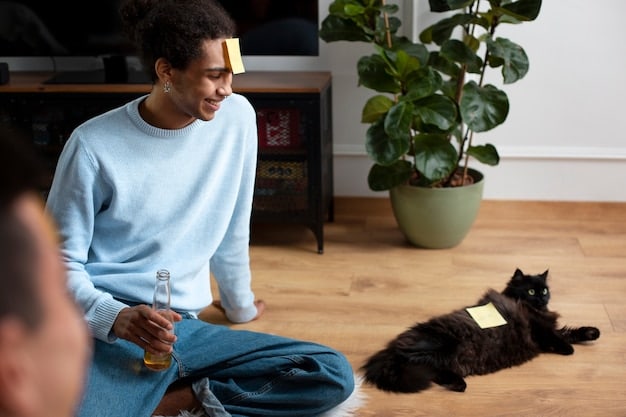Clicker Training for Cats: A Step-by-Step Guide

Clicker training for cats is a positive reinforcement technique that uses a clicker to mark desired behaviors, followed by a reward, making it an effective way to teach your feline friend essential commands and tricks.
Unlock your cat’s potential with clicker training for cats: a step-by-step guide to teaching 5 essential commands. This method offers a fun, effective way to communicate with your feline friend, strengthening your bond while teaching them valuable skills.
Understanding Clicker Training for Cats
Clicker training, a popular method for dogs, is also incredibly effective for cats. It’s based on positive reinforcement, making it a fun and rewarding experience for both you and your feline companion.
So, how does it work and why should you consider it for your cat?
The Science Behind Clicker Training
Clicker training uses a “click” sound to mark the exact moment your cat performs a desired behavior. This precise timing is crucial because it clearly communicates to your cat what they’re being rewarded for.
Think of it like this: the click becomes a signal that “yes, that’s exactly what I wanted you to do!”
Benefits of Clicker Training Your Cat
- Strengthens the bond: Clicker training requires interaction and clear communication, deepening the connection between you and your cat.
- Mental stimulation: Learning new commands and tricks provides mental enrichment for your cat, preventing boredom and promoting cognitive health.
- Reduces behavioral problems: By redirecting your cat’s energy and teaching them appropriate behaviors, you can minimize issues like excessive scratching or meowing.
- Positive reinforcement: Unlike punishment-based methods, clicker training focuses on rewarding good behavior, creating a positive and enjoyable experience for your cat.
Clicker training isn’t just about teaching tricks; it’s about building a stronger, more communicative relationship with your cat while providing them with mental and physical enrichment.
Getting Started: Essential Tools and Preparation
Before you begin clicker training, gathering the right tools and preparing the environment are essential steps. This will set you and your cat up for success.
Let’s explore what you’ll need and how to create the ideal training space.

Essential Tools for Clicker Training
You don’t need much to get started. Here are the basics:
- A clicker: Choose a clicker with a consistent and clear sound. Many options are available online or at pet stores.
- High-value treats: These should be small, tasty, and irresistible to your cat. Experiment to find what motivates them the most.
- A quiet space: Find a location with minimal distractions where your cat feels comfortable and safe.
Preparing the Training Environment
A calm and quiet environment is crucial for successful training sessions. Here’s how to prepare your space:
- Minimize distractions: Turn off the TV, put away toys, and keep other pets out of the area.
- Choose a comfortable space: Select a room where your cat feels relaxed and secure.
- Keep sessions short: Start with training sessions that are only 5-10 minutes long to keep your cat engaged and prevent frustration.
With the right tools and a well-prepared environment, you’re ready to begin the exciting journey of clicker training your cat.
Step-by-Step Guide: Charging the Clicker
Before you can start teaching your cat commands, you need to “charge” the clicker. This means associating the click sound with something positive, like a treat.
This association is crucial for the clicker to become an effective communication tool.
The Charging Process
Charging the clicker is simple but important. Follow these steps:
- Hold the clicker and a treat: Have both ready in your hand.
- Click the clicker: Immediately after the click, give your cat a treat.
- Repeat: Repeat this process several times in a row.
Observing Your Cat’s Reaction
Pay close attention to your cat’s reaction. Are they looking at you expectantly after the click? This indicates they’re starting to understand the connection between the click and the treat.
Troubleshooting Tips
- If your cat is scared of the clicker: Start by clicking the clicker softly from a distance, gradually increasing the volume as they become more comfortable.
- If your cat doesn’t seem interested in the treats: Try different types of treats, or try using a favorite toy as a reward instead.
Charging the clicker is the foundation of successful clicker training. Once your cat associates the click with positive reinforcement, you can begin teaching them specific commands.
Teaching 5 Essential Commands
Now that your cat understands the clicker, you can begin teaching them essential commands. Start with simple behaviors and gradually increase the complexity.
Here are five commands you can teach your cat using clicker training:

1. Sit
Lure your cat into a sit position by holding a treat above their head. As their rear touches the ground, click and give them the treat.
2. Come
Say your cat’s name followed by “come.” If they move towards you, click and give them a treat. Gradually increase the distance as they improve.
3. Stay
Ask your cat to sit or lie down. Then, say “stay” and hold your hand up. If they stay in position for a few seconds, click and give them a treat. Gradually increase the duration.
4. High-Five
Hold your hand out and wait for your cat to touch it with their paw. As soon as they do, click and give them a treat.
5. Target Training
Use a target stick (or a pen) and lure your cat to touch it with their nose. Click and reward. This can be used to guide your cat to specific locations or perform more complex behaviors.
Remember to keep training sessions short, positive, and rewarding. Celebrate your cat’s successes and be patient as they learn. With consistent practice, your cat will master these essential commands.
Troubleshooting Common Clicker Training Issues
Even with the best preparation, you may encounter challenges during clicker training. Understanding how to troubleshoot common issues can help you stay on track.
Let’s address some frequent problems and their solutions.
Your Cat Loses Interest
If your cat seems uninterested in training, consider these factors:
- Treat value: Are you using high-value treats that your cat truly loves?
- Session length: Are your sessions too long? Keep them short and engaging.
- Boredom: Are you repeating the same commands too often? Introduce variety and new challenges.
Your Cat Gets Frustrated
Frustration can arise if the training is too difficult or confusing. Try these strategies:
- Simplify the steps: Break down complex behaviors into smaller, more manageable steps.
- End on a positive note: Always finish a training session with a command your cat knows well.
- Be patient: Remember that every cat learns at their own pace.
General Tips for Success
Here are some additional tips to ensure a positive training experience:
- Consistency is key: Train regularly, even if it’s just for a few minutes each day.
- Use positive reinforcement only: Avoid punishment or scolding.
- Celebrate successes: Praise your cat and reward them generously for their efforts.
By addressing these common issues and following these tips, you can overcome challenges and create a rewarding clicker training experience for both you and your cat.
| Key Point | Brief Description |
|---|---|
| 🐾 Charging the Clicker | Associate the click with a positive reward (treat) for effective training. |
| 🎯 Target Training | Use a target stick to guide your cat, rewarding them when they touch it with their nose. |
| ⏱️ Short Sessions | Keep training sessions brief (5-10 minutes) to maintain your cat’s focus. |
| 🏆 Positive Reinforcement | Focus on rewarding good behavior; avoid punishment for best results. |
Frequently Asked Questions
▼
Most cats can benefit from clicker training, but it requires patience and understanding of your cat’s individual personality and preferences. Some cats respond more quickly than others.
▼
Start by clicking the clicker softly from a distance, gradually increasing the volume as they become more comfortable. Pair the sound with treats to create a positive association.
▼
Keep training sessions short, about 5-10 minutes, and aim for daily training. Consistency is key, but avoid overtraining to keep your cat engaged and eager to learn.
▼
Use high-value treats that your cat loves. Small, soft treats are ideal. Experiment to find what motivates your cat the most, such as freeze-dried meat or specialized cat treats.
▼
Yes, you can redirect unwanted behaviors by teaching alternative, desired behaviors. Reward your cat when they perform the desired behavior instead of the unwanted one, using the clicker to mark the correct action.
Conclusion
Clicker training for cats is a rewarding experience that strengthens the bond with your pet. By understanding the principles, preparing effectively, and staying consistent, you can unlock your cat’s potential and enjoy a more communicative relationship.





